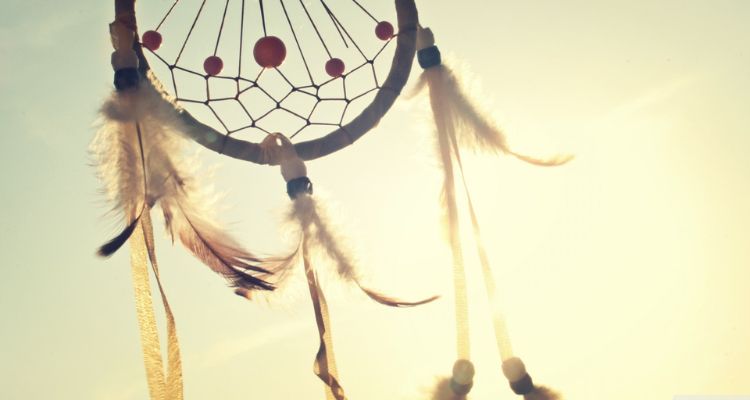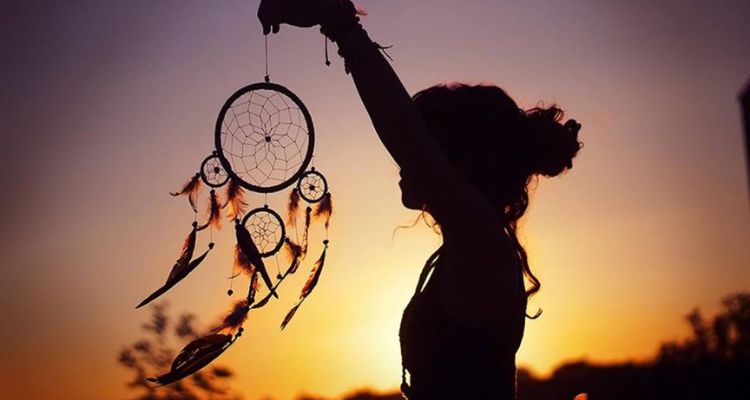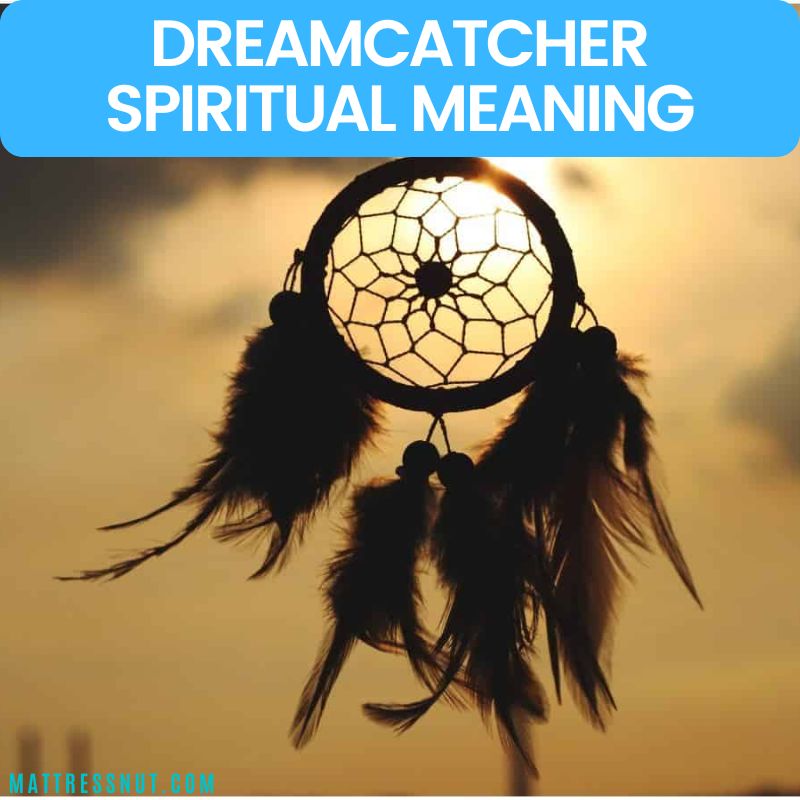Dreamcatchers are pretty simple to understand and self-explanatory. They are meant to snatch away any bad dreams. But these dreamcatchers are not just limited to this.
These beautiful-looking talismans with Native American toots have a rich history and tradition. They are far more than just some eye-catching displays. Anyone looking to buy a dreamcatcher should know the true meaning of it and respect the culture from which they originate.
In this guide, we will talk about these dreamcatchers in detail. So, if you are looking to buy one know all this beforehand.
What’s a Dreamcatcher?
Dreamcatcher is a round-shaped small talisman that people hang by their bed to capture bad dreams. It helps deliver good dreams and thoughts during your sleep.

These dreamcatchers were made using wooden hoops webbed in a thread. They feature handmade beads, features, and leather. Only organic and natural materials are used in the construction of these talismans.
These dreamcatchers can be only a few inches wide. Those traditional talismans were nothing like those in cheap gift shops today. Instead, you see those vivid-colored plastic dreamcatchers with faux feathers these days.
They are nothing but the commercialized version of the original talisman. We will talk about them briefly and why you should buy them. Each of these traditional dream catchers works differently from others based on different legends.
But the overall meaning is the same: to catch harmful thoughts and bad dreams and deliver good ideas and dreams during sleep. These dreamcatchers were made for small children or infants, hanging right above their cribs.
Is a Dreamcatcher Dangerous?
Dreamcatchers are not dangerous. They were meant to take away evil thoughts and dreams and bring in good ones. So, there was not much magic or voodoo involved with them.
You can conveniently use them in your home and for your family members. But only go for the one that comes from a Native American store. Those colorful, large-sized dream catchers will not do anything if at all they can.
The Legend Behind the Dreamcatchers
Ojibwe – The Origins
Different Native American cultures have different versions of dreamcatchers embedded with their traditions. However, most historians agree that the Ojibwe culture is where these dreamcatchers came from.
The legend focuses on a spider woman, Asibkaashi, who is the spiritual protector of the people of this culture, and she protects the children from any harm.
With the Ojibwe people expanding across the land over the years, the spider lady found it tough to protect everyone from harm’s way.
The web inside the willow hoop is like a spider’s web; it would catch the bad dreams, thoughts, and spirits that might linger around, and it wasn’t originally about bad dreams. From this time, the legend grew and branched out with different meanings based on who interpreted the history of these dreamcatchers.
Lakota Legends
Like Ojibwe, the Lokoata Legends begin with some spiritual beings who link with siders. Iktomi had formed a dreamcatcher to capture good ideas on this website so they don’t lose it. It filters out the bad thoughts from the central hole without harming their people.
The talisman is a symbol with a perfectly round hoop, and its symbol is the moon and the sun. Real soft feathers, usually owl feathers, are the ladders that the good dreams or thoughts use to float down right into your mind.
The number of points that the threaded web touches are also symbolic. If there are 13 points, it represents the different phases of the moon. If there are 8, it’s the leg of the spider woman. In the case of 7, there are seven prophecies, 6 is an eagle, and 5 for a star.
Apart from the feathers, sacred tokens and beads can be added. And those stones and gems can represent good dreams. If there is just one stone in the dreamcatcher, it represents the creator.
Why Understanding the Dream Catcher Symbolism Important?
These dreamcatchers closely link with the noble Native American legends. So, can anyone of us buy these dreamcatchers for their prettiness or legends?
This talisman is the symbol of unity among the Native Americans. It shouldn’t be an over-commercialized or misused piece of plastic decoration on some landfill site. And this is where cultural appropriation pops up. It’s controversial and downright offensive to go for a piece of tradition from any culture and not even try to understand its meaning.
But cultural appreciation should be highlighted. It means that owning a dreamcatcher and understanding and respecting its meaning, and supporting the Native American people should be promoted.
And this is exactly why we highly recommend you to purchase these talismans from Native American craftspeople. You can buy them from all Indian territories across the US and Canada. You must look for tribal gift shops and attend those Native Indian events to learn more about their culture.

Dreamcatchers in the Modern Day
During the 1960s and 70s, Native Americans used these dreamcatchers to symbolize unity in the Pan-Indian Movement. And after that, these talismans became native crafts and souvenirs.
People from all across the globe highly regard this talisman as an exciting and beautiful item. They nowadays make dreamcatchers of different types, made from different materials and styles.
Jewelry and imagery of these dreamcatchers have gained popularity in the market as some fashionable trends because they are quite enticing.
But these dreamcatchers are far from their traditional counterparts. These are overseas and available in various vivid colors, most of which are of plastics or other artificial materials.
The traditional ones were smaller and made of wood, leather, and natural feathers. According to numerous Native American cultures, these dreamcatchers have become too commercial that they have lost their true meaning.
So, Is It Bad to Have a Dreamcatcher At Home?
No, dreamcatchers only catch your evil thoughts and dreams. Another purpose it serves is releasing good vibes and protecting the residents of your home.
And this is more around the original pieces and not the commercialized women’s that are available in different stores. These vivid-colored dreamcatchers have lost their true meaning, so they can’t do any harm or good. But you need to respect the traditional culture and should not exploit it for any reason.
Is There a Way to Activate a Dreamcatcher?
The traditional blessing from Native Americans on these dreamcatchers is smudging. And for this, you will need to induce smoke using dry plants.
You must surround the pile with rocks and bricks and put dry plants into one. Now, carefully light those plants and let the smoke gradually waft up surrounding your dreamcatcher. Most people believe that the best color for a dream catcher is blue or white.
It is because both these colors represent hope and purity. The white color symbolizes light, goodness, freshness, and calmness, so you may go for the white ones too.
Can a Dreamcatcher Expire?
Dream Catchers catch good thoughts and dreams, and then they reach the sleeper, but bad thoughts and dreams are caught within the web, and the daylight destroys them.
They don’t expire because they don’t have any chemicals in them. But, as they get old, these dream catchers don’t become as effective as they once were.
What About Those Black Dreamcatchers – Are They Bad?
Black color often associates with elegance, power, death, formality, mystery, and evil. Black is a mysterious color related to the fear of the unknown. But overall, the connotation is negative for this color.
However, black represents authority and strength too. So, a black dreamcatcher is not bad in itself. It keeps evil away and brings in power and strength.
Always ask the Native American craftspeople about the specific purpose of a black talisman when you see one. They will guide you about the original purpose of that particular dreamcatcher.
Does Having Dreamcatcher Tattoos Bring Bad Luck?
The tattoos of these dreamcatchers don’t have anything to do with bringing good luck or snatching away bad luck. They are just tattoos and nothing beyond that.
Some people get these tattoos to avoid evil, but it has no reality. If you want to use a dreamcatcher, buy an actual piece from a Native American craft shop.
Throwing away a dreamcatcher can bring bad luck because some negative spirits might try to trouble you. Spirits rule human veins, so they have to take control and rule those spirits.
Key Takeaways: Understanding the Essence
What’s a Dreamcatcher?
Dreamcatchers are round talismans, originally made from organic materials, meant to filter dreams and ensure only positive thoughts reach the sleeper.
Modern vs. Traditional
Modern dreamcatchers, often made from artificial materials, deviate from the traditional, organic ones in terms of authenticity and meaning.
Origins and Legends
Rooted in the Ojibwe culture, the dreamcatcher legend revolves around a spider woman named Asibkaashi, designed to protect people from negative energies.
Symbolic Meanings
Every component of a dreamcatcher, from its hoop to the beads and feathers, carries a significant meaning, often tied to nature and spiritual beliefs.
Appreciation Over Appropriation
While dreamcatchers have become popular globally, it’s crucial to approach them with respect, understanding their cultural significance, and avoiding mere decorative misuse.
Modern Day Usage
Dreamcatchers have transitioned from sacred items to commercial souvenirs, with many now designed more for fashion than spiritual purpose.
Activating a Dreamcatcher
The traditional method of activating or blessing a dreamcatcher is through smudging, using the smoke from dried plants.
Conclusion:
Dreamcatchers have a rich history as it is tightly embedded in the Native American culture. It was a highly prestigious piece back in the day, but commercialization has turned it into a decorative item.
It not only looks beautiful but has globally gained recognition in recent times. And that is why you see those vivid-colored items on the market far from the original piece.
According to the Native Indian people, these dreamcatchers have lost their true meaning, and keeping them as if they would bring any good luck is irrelevant now. But people still believe in them, and many even have dreamcatcher tattoos.
Dreamcatcher FAQs
Is owning a dreamcatcher dangerous in any manner?
According to the legend, dreamcatchers only catch dreams and thoughts. Bad dreams and thoughts are away, while good dreams and thoughts are ladder down on the sleeper. They don’t have anything to do with voodoo or black magic.
What are the most appropriate colors for an authentic dreamcatcher?
The traditional dream catchers used to be white or blue. Both these colors are symbols of hope and purity. Most of them were the same color as willow wood. But the ones we find in decoration stores are less meaningful as they are all available in bright and vivid colors to commercialize.
Where can I find a traditional dreamcatcher?
The ones available in pawn shops and stores are not the original thing. To buy an original piece, you should consider going to a Native American craft shop and buying a traditional dreamcatcher.
These are the original items and will tell you about the original meaning of the dreamcatcher you purchase from them. The commercialized counterpart is a mere piece of decoration and nothing else.

